| Spotlight
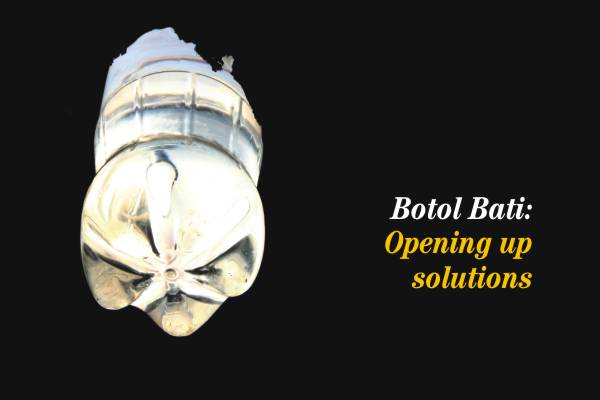
“The unpreparedness of the educated classes, the lack of practical links between them and the mass of the people, their laziness, and, let it be said, their cowardice at the decisive moment of the struggle will give rise to tragic mishaps.”
- Frantz Fanon, The Wretched of the Earth
Saad Adnan Khan
Photos: Kazi Tahsin Agaz Apurbo
As national and international politicians and policy makers, indulge in blame games, spend their so-called-intellect behind big, undemocratic solutions (like dams and nuclear power plants), fight over the amount of water that should be shared between borders and make decisions in secret, a free, down-to-earth soul has started to bring changes through a small, simple solution. Sajid walks through the narrow dusty alleys of the Muslim camp slum in Mirpur, looking for houses where day light cannot reach, because the houses are so cramped. As a result, the slum people end up using illegal lines to light up bulbs, which eventually lead to the misuse of 275 Megawatt of electricity in Dhaka slums alone, every single day. Sajid goes from door to door, convincing people that the solution he has to offer, to reduce such misuse and also light up their homes, is not only better for the slum dwellers, but also for the entire nation.
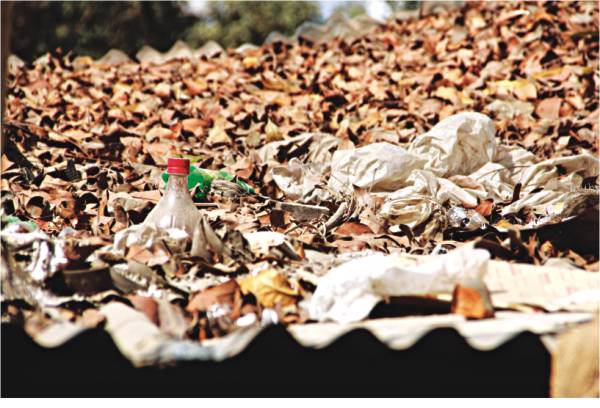
Botol Bati: one-third outside the roof, two-third inside the house.
The solution that Sajid Iqbal, a fourth year student of Environmental Science and Management Department in North South University, has, requires only a few simple things to make it feasible- a small piece of corrugated tin sheet, some tools to cut and cork, rebids, pudding and most importantly, a 2 liter plastic bottle.
“Take a tin frame, and make a small hole in it where you have to fit the bottle. One third of the bottle will be exposed outside, while two third will be inside the house. The bottle will be filled with water. Place the sheet with the bottle on the tin roof of the house, and rebid the sheet with the tin roof. Then place pudding around the bottle and the sheet, so that when it rains, water does not go inside the house. If it was just a hole to let light inside the house, then the light will only fall in one direction. Using the bottle in this case will allow light to enter the bottle and reflect all around inside the house due to the water inside the bottle. The bottle does not need to be replaced for one or one and a half year. One bottle produces light equivalent to a 55W power bulb,” explains Sajid enthusiastically. The solution that Sajid has in hand is an innovative Environment-friendly Solar Bottle Light (ESBL).
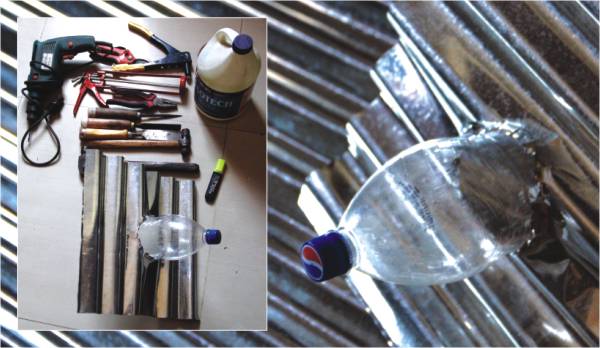
The tools and materials required to make Solar Bottle Light.
ESBL was first used in Philippines. The simple mechanism of the solar bottle light is easy for anyone in slums to install. Sajid got to know about this technique last year, when his friend shared a youtube link of facebook. The video on the solar bottle light instantly caught Sajid's attention. “I wanted to find out if this has been done in Bangladesh or any other South Asian countries for that matter. It turns out there hasn't been any such initiative. I realised that it was very easy to implement and can be significant for our country, given that 70.4 percent of total urban population lives in slums in urban areas of Bangladesh, and there is a large misuse of electricity in the slums,” says Sajid.
| |
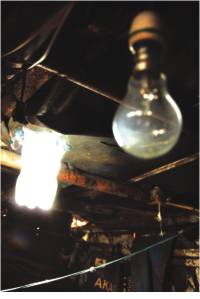 |
| |
Environment friendly alternatives are beneficial in the long run. |
Sajid approached his friend Al-Mamun, who is an electrician and air-condition technician. Sajid and Mamum play for the national sports team of fencing. Mamun never had the privilege of getting proper education. Sajid taught Mamun how to make the entire model, and since the beginning Mamun has been working with Sajid to install the solar light bottles. They have installed solar bottles in eleven houses so far for free. Along with Sajid's self-investment in the project, Sohel Rana, who is Sajid's coach of the fencing team and a good friend, also assisted Sajid financially to buy the tools. Maksud, who lives in the slum escorted Sajid and his group in the slum. Maksud, being someone from the slum community, was a great help to Sajid, because it was through him that Sajid gained a lot of trust of the slum people.
One of Sajid's main objectives is to create awareness among slum people of power misuse, so that they take personal initiatives to improve the situation, because after all one of the key factors of sustainable development is the development or change in people's attitude regarding the environment. Some people still switch on bulbs, even after the installation of the solar bottle light, out of “habit”. “We are trying to make the slum people aware of and interested in alternative renewable energy and trying to involve them with our project, for installing ESBL and to motivate others. This technology is not only necessary for Bangladesh, but also for many other South Asian and African countries,” says Sajid. Such simple technology is undoubtedly environment friendly. The use of solar bottle bulb aims to:
· Reduce the misuse of electricity during day time
· Reduce consumption of resources
· Reduce the use of illegal electricity lines
· Reduce carbon emission
· Help with the recycling of plastic bottle
· Help poor people in the slum to get light during the day at a cheap rate
· Save energy
This technology can be a good source of light for single shaded factories, industries and households for day time lighting purpose, which will reduce electricity consumption. It can also be helpful for those who do not have any electricity connections in rural areas.
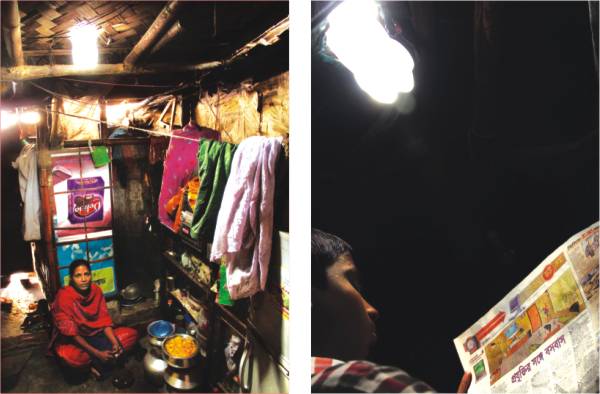
With the installation of ESBL, the people in the slum do not need to rely on bulbs during the day time to do their work.
Shabana lives in a small house in the slum with her son Shoheb, who studies in class 1 at a nearby local school. Shabana makes saris for living. She also cooks at a mess. Since day light did not reach inside her home, she used to make saris using bulbs, candles or hurricane lamp during the day. After installing the solar bottle light, she does not feel the need to switch on the bulb during the day time, nor spend extra money behind candles and lamps anymore, to work on her saris, her economic mean to support her family.
Sajid took part in the South Asian Youth Society competition 2012, one of the programmes under the US Embassy. He submitted a project proposal of using and installing solar bottle light as a social business model. His proposal won the second prize. “If this technology gets more funding, the technology can be installed in a mainstream manner,” believes Sajid. Sajid will work with a Nepalese SAYS participant Prasanna Paudel, who will carry out the project in Nepal, turning the project into a transnational venture. Prasanna is currently doing his bachelors in Business Information System (BBIS) at the Kathmandu College of Management. “The solar bottle project would be really helpful to the Nepalese people particularly to the ones living in slum areas and also upper hilly region where houses have small windows and not enough natural light. I have started doing some research about the feasibility of this project in Nepal. I aim to start up the same project in coordination with Sajid and South Asian Youth Society. I will coordinate with SAYS and Sajid, who will help me with the financial and technical part. The project is so useful for a country like Nepal where we have to face energy crisis many times a year and the electricity is highly under produced,” says Prasanna.
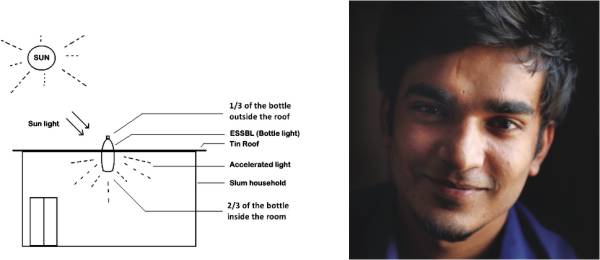 |
Illustration by Sajid Iqbal. |
Sajid Iqbal. |
Sajid consulted the project with Dr Shaikh Tanveer Hossain, Sustainable development consultant, Friends in Village Development Bangladesh. “This technology can be very important when it comes to cottage industries and households, because industries are using large amount of electricity. Regarding the slums, there cannot be a large impact unless the slum people are made aware, because they are already using illegal electricity lines for free. Change will only come if the awareness is made through government organisations and NGOs,” says Dr Hossain.
Sajid acknowledges that he could not have done the project just by himself, and therefore needed a collective effort from his friends. The faith that Sajid has shown in the simple mechanism of the ESBL is integral to our understanding of alternatives- alternative to dams, quarrels over water sharing, environmentally degrading industrialisation, being indifferent to the poor and their silent contribution to the economy. The bigger picture is to mobilise and motivate the people of the grassroots to participate in bringing about sustainable human development that will benefit themselves and the entire community in the long run, because after all climate change will affect the poorest and the most vulnerable in any case. Maybe it is time that writers, filmmakers, painters, government officials and policy makers start thinking about and acknowledging alternative solutions and small things.
 |
Sajid and his friend Al-Mamun. |
Sustainable development for a better future. |
|
